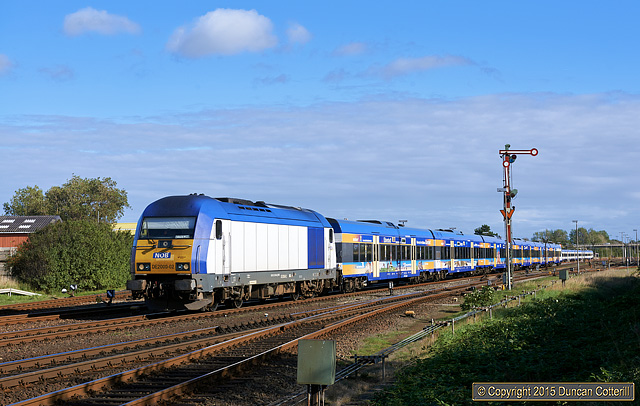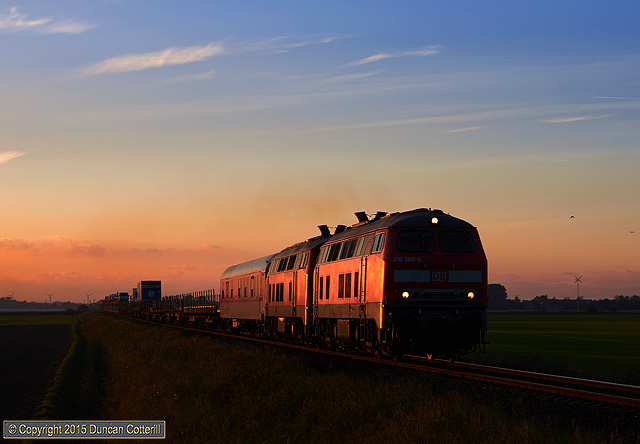TRAINS, PLAINS & AUTOMOBILES
Diesel Hauled Car Trains On The Flatlands Of Nordfriesland
Germany - 22 September to 01 October 2015 - Report by Duncan Cotterill

INTRODUCTION
After thoroughly enjoying my two summer trips to photograph diverted freights on the Marschbahn in the summers of 2014 and 2015, I went back for 10 days in late September 2015. The objective was to cover the section of the Hamburg to Westerland line that hadn’t hosted diverted freights, the last 39km from Niebüll to Westerland.This section is mainly single track, largely semaphore signalled, very intensively operated and includes the Hindenburgdamm, an 8 km causeway across the Wattenmeer (Wadden Sea) to the island of Sylt. Everything is loco hauled, or pushed, and with motive power changes in the offing that will make the line a lot less appealing, it seemed like a good time for a visit.
More details of the line and its train services can be found in my July 2014 report but essentially there are paths for up to four trains each way every hour, two passengers and two Sylt Shuttle services conveying motorists in their vehicles between the mainland and the island of Sylt, which is only accessible by rail, air and the occasional boat.
Marschbahn Essence
Double headed 218s on a well loaded Syltshuttle car-carrier, semaphore signals and a dramatic sky. That just about sums up the essence of the Westerland end of the Marschbahn. What a still picture can't convey is the sheer volume of traffic. For much of the day a train would pass this spot every 15 minutes and that was just in one direction. Traffic in the other direction was just as heavy and every single train, either way, was loco worked.218.385 and 218.319 approached Klanxbüll with Niebüll bound SyltShuttle AS-K1415, the 08:40 departure from Westerland, on 27 September 2015.
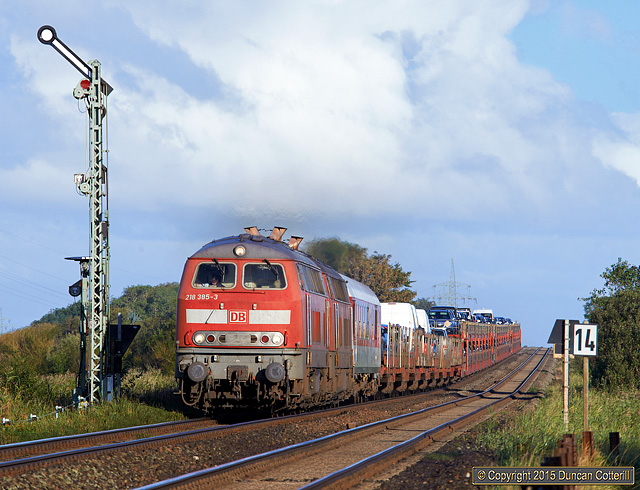
REGIONAL PASSENGER SERVICES
Most passenger trains are operated by Nord-Ostsee Bahn, a subsidiary of Veolia, using single-deck push-pull sets with a class 223 or 251 diesel at the Westerland end. A few peak services had a second push-pull set coupled ahead of the loco, sandwiching it in the middle of the train. These were invariably powered by the 251s. Analysis of the trains seen, revealed a fairly confused picture and almost everywhere there seemed to be a pattern, there was an exception to call it into question.The favourite trains for 251s appeared to be 81709 (6/6), 81814 (6/6), 81752 (4/4) and 81727 (5/5) on weekdays and 81746 (5/6) and 81741 (5/7) any day. Numbers in brackets indicate the number of days the train was seen with a 251 followed by the total number of days the train was seen. 81798 and 81799, which only operate on Saturdays also seem a good bet for a 251 based on my observations and what I’ve seen reported elsewhere. Of the other trains, most were worked by a 251 on at least one occasion but there didn’t seem to be much of a pattern.
It was expected that there might be some sort of daily pattern, even if it didn’t carry over from one day to the next, but that couldn’t be relied upon either and it wasn’t uncommon for sets and locos to be swapped during the day. It wasn’t even possible to predict reliably which trains would be worked by sandwich sets although 81709 usually was between Westerland and Niebüll on weekdays with 81814 taking the extra coaches back to Westerland. The afternoon pattern was less predictable with 81727 and 81817 often being sandwiches on weekdays but not every weekday. On the Saturday 81414, 81799 and 81798 were all worked by the same sandwich set.
Schleswig-Holstein land has 15 class 245 Traxx multi-engined diesels on order to work regional passenger services, more than enough to replace all the 223s and 251s on the Marschbahn. The first of these appeared on several occasions during my visit, always on trains 81710 10:40 ex Hamburg and 81723 14:22 ex Westerland. The trains were formed of the usual push-pull set but the 245 ran round at Westerland and hauled the train back south on every occasion it was seen. I was surprised to see it was registered to D-NOB as I thought the operator of these locos on the Marschbahn was still to be decided.
Locos Seen :
223.001 /010 / 011 / 012 (ER 20-001 / 010 / 011 / 012),223.053 / 054 / 055 (DE2000-01 / 02 / 03),
245.201,
251.002 / 003 / 007 / 008 / 010 (DE2700-02 / 03 / 07 / 08 / 10)
The low numbered 223s were all in the old insipid yellow and silver Dispolok livery but had lost their Dispolok branding. 223.011 had been re-registered to D-BRLL (Beacon Rail Leasing Limited) and carried BRLL logos on the ends. The other three were still registered D-DISPO.
The higher numbered 223s were registered D-NOB and carried Veolia’s blue, white and yellow colours. 223.055 carried a modified version advertising Radio Schleswig-Holstein on the sides.
The 245 was registered D-NOB and carried an attractive two-tone blue and white livery that made it a leading contender for the lipstick on a pig award.
The 251s were registered to Veolia (D-VL), NOB’s parent company, and most carried Veolia’s blue, white and yellow livery but without the NOB branding seen on the 223s. The exception was 251.003, which appeared to have been the subject of a graffiti attack by a talented four year old.
Nord-Ostsee Bahn
Train NOB81750 was typical of regional services on the Marschbahn. Like most Nord-Ostsee Bahn trains it was formed of a six coach push-pull set powered by a class 223 diesel at the Westerland end.223.010 worked the 16:31 Niebüll - Westerland service west from Klanxbüll on Tuesday 29 September 2015.
NOB have three class 223s in their own blue, white and yellow colours but this loco was one of several hired from MRCE Dispolok but now possibly owned by Beacon Rail.
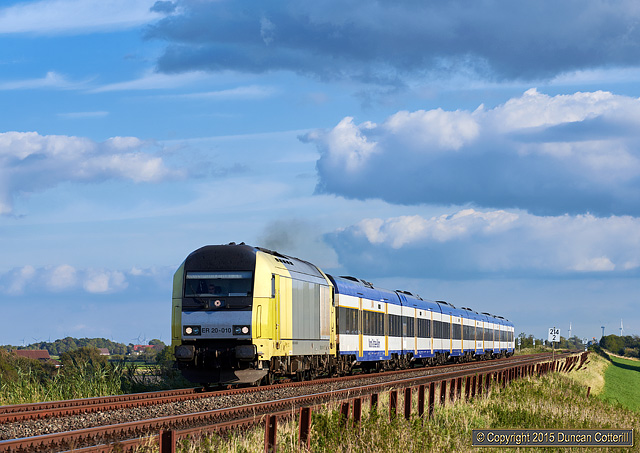
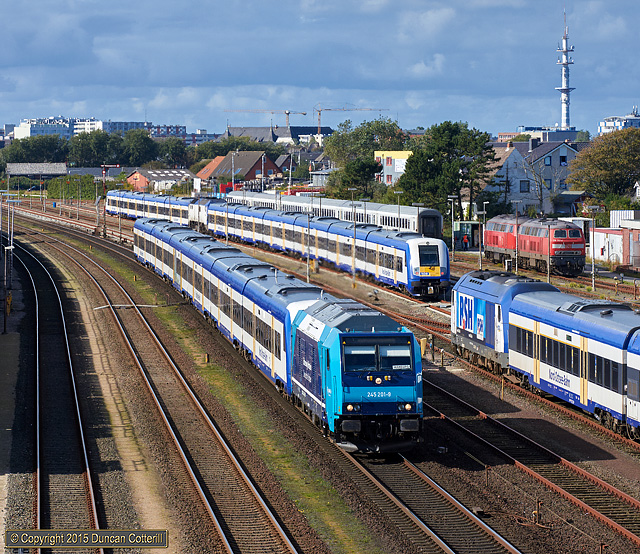
The Blue Reaper Cometh
New class 245 Traxx multi-engine diesels are expected to replace NOB's class 223s and 251s and DB's class 218s on the Marschbahn over the next couple of years. 245.201, the first of Schleswig-Holstein's 15 locos for regional services, was already working NOB trains in September and is seen here leaving Westerland on Monday the 28th on its usual turn, NOB81723, the 14:22 to Hamburg-Altona.In the background DB's 218.344 and 218.362 ran round the stock for IC2073 while NOB's 223.055 in RSH livery and an unidentified class 251 in the middle of a sandwich set waited for the late afternoon peak.
Big MaK
NOB's "Big MaK" diesel 251.003 stood out from the crowd with its nursery school inspired livery.The loco propelled NOB81715, the 10:22 from Westerland to Hamburg-Altona, over the Hindenburgdamm on 28 September 2015.
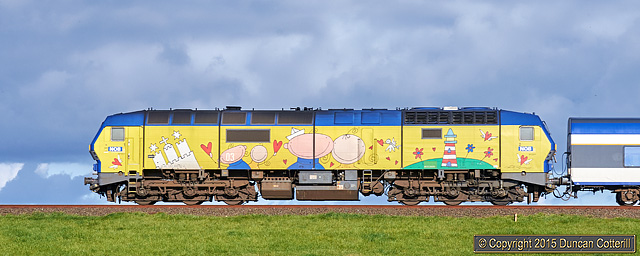
INTER CITY SERVICES
The Marschbahn’s other passenger service is operated by DB and consists of four pairs of InterCity trains a day, connecting Westerland with destinations such as Köln, Frankfurt, Berlin, Dresden and Karlsruhe. These are hauled in both directions by pairs of class 218 diesels based at DB's Niebüll depot. The diesels work between Westerland and either Itzehoe or Hamburg, where electric traction takes over. There's an eight day diagram for the four pairs of loco required to work these trains but in effect it’s four one day diagrams, each for a pair of locos. In other words, the same pair of locos is booked to work the same pair of trains day after day.Locos do have to change eventually and the swaps I saw took place at Westerland with the new locos coming from Niebüll on a Sylt Shuttle and the replaced locos returning the same way. One reason for swapping locos could be the fairly tight turnrounds at Westerland for IC2314 to IC2315 and IC2072/2074 to IC2073. After arrival the train has to unload, back out to the carriage sidings, the locos have to run round, couple up and then back the stock into the station again, all in less than 50 minutes. In the case of a late arrival, it would be far quicker to keep the train in the station and drop a pair of shuttle locos on the back, allowing an on time departure. That’s probably what happened on 23 September when 218.340 and 218.315 arrived with a late running IC2314 and were replaced on IC2315 by 218.385 and 218.319. The following day 218.369 and 218.341 replaced 385 and 319. In both cases the replaced locos remained on shuttle duties for the next few days. Fortunately the inbound services with tight turnrounds, IC2314 and IC2072 (IC2074 at weekends) were good timekeepers. The same couldn’t be said of the afternoon/evening arrivals, IC2310 was often late, usually by no more than 15 minutes, but IC2374 regularly clocked delays of 30 minutes or more.
There is a 19:22 Westerland – Niebüll RB service, running daily, that’s booked to be formed of DB IC stock, so presumably it’s hauled by a pair of 218s as well. A notice at Westerland apologises for the fact that the IC coaches used on this service don’t meet the standard that NOB’s customers are used to! This train ran in the dark in late September so was never seen as I’d packed up by then. Presumably the locos and stock work back to Westerland as ECS in the evening or overnight as there’s no balancing passenger service.
Locos Seen :
218.340+218.315 worked IC2314 on 23/09 but were replaced at Westerland
218.385+218.319 worked IC2315 on 23/09 and IC2314 on 24/09 then were replaced
218.369+218.341 worked IC2315 on 24/09 and were still on IC2314 and IC2315 when I left
218.362+218.344 worked IC2072 (or IC2074) and IC2073 throughout
218.313+218.381 worked IC2311 and IC2310 throughout
218.345+218.386 worked IC2375 and IC2374 until 24/09
218.359+218.371 worked IC2375 and IC2374 from 25/09 until I left
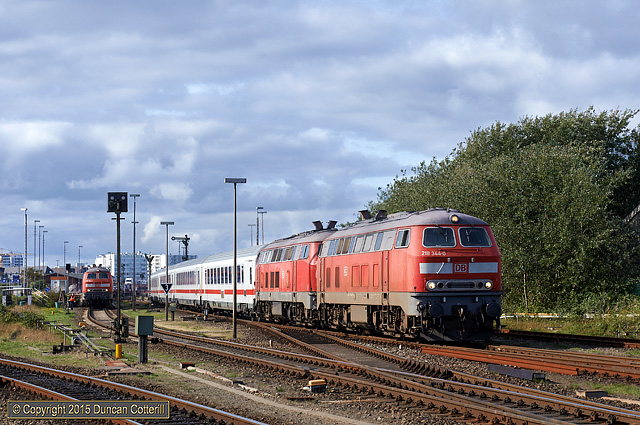
Regular Working
218.344 and 218.362 left Westerland with IC2073, the 14:56 to Berlin-Südkreuz, on the afternoon of 28 September 2015, the last of four daily InterCity departures from Westerland.The same pair of locos are diagrammed to work the same pair of trains every day and this pair stuck to IC2072 (IC2074 at weekends) and IC2073 for the duration of my visit.
On the left 218.386 and 218.372 waited to follow with the 15:10 SyltShuttle to Niebüll.
Exceptional Timekeeping
IC2374, the 09:10 from Karlsruhe to Westerland, was a very poor timekeeper, often reported running over 30 minutes late.Exceptionally, it was heading for an on time arrival at Niebüll on 28 September, passing Risum-Lindholm at 18:04 behind 218.371 and 218.359.
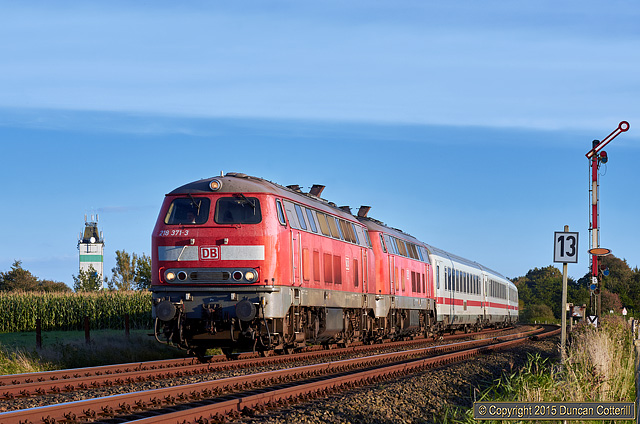
SYLT SHUTTLE CAR CARRIERS
The Sylt Shuttle is an interesting operation using pairs of DB class 218s on long trains of mixed double and single-deck car transporters. There's sufficient clearance to take full size articulated lorries and coaches on the single deckers and quite large vans on the top deck of the double deckers, so all types of road vehicle are catered for. At weekends trains consist of three 9-section articulated double-deckers and around ten single-deckers, during the week there are usually two 9-section double-deckers and about sixteen single-deckers. Each consist is completed by a coach that carries motorcyclists and their bikes, otherwise drivers and passengers travel in their vehicles.DB publish a timetable for Sylt Shuttle services showing which trains run on which days but the time shown is the check in time for motorists, not the departure time for trains, which is around ten minutes later. Booked departure times are XX:16 and XX:46 from Niebüll and XX:10 and XX:40 from Westerland but trains often leave a few minutes early. Running time is around 35 minutes.
Locos run round at each end so all trains are hauled. At Niebüll this is simple enough as the terminal is in the form of an island and the locos can run round the other side of the island after arrival. At Westerland it's more complex with unloading taking place on the north side of the station and loading on the south side. After unloading, trains push back into the yard then pull forward into the loading siding. At quieter times the locos then run round but when trains are running every half hour, a different pair of locos will back on and take the train out.
On the Monday morning two triple headed shuttles were seen running from Westerland to Niebüll. In each case the third loco didn’t appear to be working and was half of a pair that had been working shuttles over the weekend. It looked like they were spare engines being ferried back to Niebüll, saving a path and a crew. There’s no guarantee that these are regular workings but it could be worth keeping an eye on the 09:10 and 10:10 shuttles from Westerland on a Monday.
The weekend service, with trains running every half hour for most of the day, requires six pairs of locos with each pair of locos completing a cycle every three hours, so the locos that work the 08:16 from Niebüll should also work the 11:16, 14:16 etc. The weekday service manages with five pairs of locos working an hourly service with a few additional trains at peak times. On weekdays the cycle time is generally four hours. Loco swaps were quite common on weekdays with one pair being swapped for another pair or one loco in a pair being replaced by another. Swaps always happened at Niebüll.
Locos Seen :
A total of 19 different locos were seen on shuttles, running in 16 different pairings. The 218s are based at DB's Niebüll depot and are in a common pool with those used on InterCity trains. Ten of the locos seen on shuttles were also seen on InterCity workings at some stage.218.314 / 315 / 319 / 340 / 341 / 342 / 345 / 359 / 363 / 364 / 369 / 371 / 372 / 376 / 380 / 385 / 386 / 389 / 397
Sylt Shuttle
With no road access and potential ferry routes restricted by the shallow waters of the Wadden Sea, there's only one practical way to take a road vehicle to the island of Sylt, DB Autozug's regular SyltShuttle service.218.376 and 218.389 were into their stride as they set off across the Hindenburgdamm in glorious afternoon light with westbound shuttle AS-K1446 on 29 September 2015.
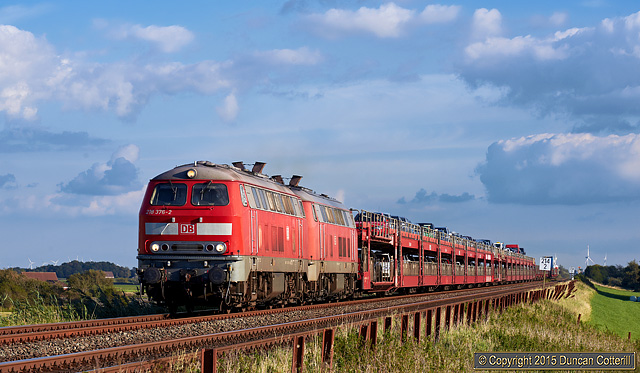
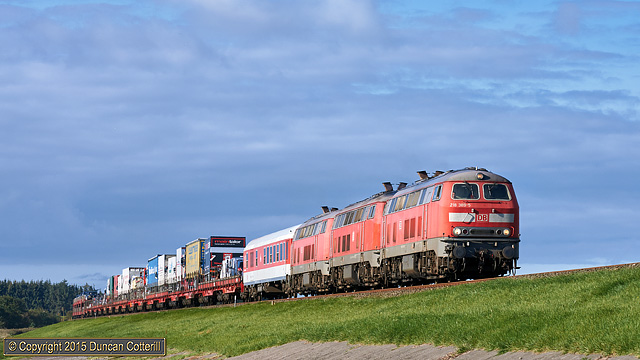
Triple Traction
Triple headed SyltShuttles are unusual but have been reported occasionally before. This was the second of two such trains ran that ran on Monday 28 September 2015.218.389, 218.376 and 218.315 led AS-K1421, the 10:10 Westerland - Niebüll shuttle, onto the Hindenburgdamm on the morning of 28 September 2015.
Klanxbüll Crossing
218.385 and 218.319 approached Klanxbüll with AS-K1419, the 09:40 SyltShuttle from Westerland to Niebüll, on Saturday 26 September 2015. In the distance, Westerland bound AS-K1418 climbed the ramp onto the Hindenburgdamm.On summer Saturdays shuttles were due to cross west of Klanxbüll every half hour from 08:27 to 17:27 and the Sunday service was almost as intense.
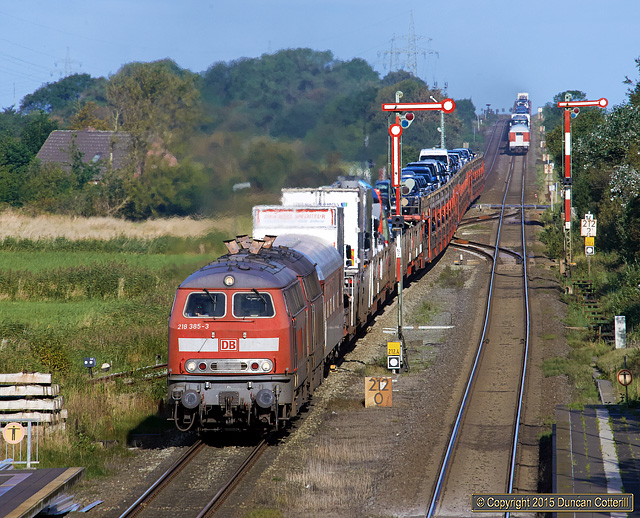
FREIGHT
There is freight traffic at the north end of the Marschbahn but not a lot. A freight is booked to leave Niebüll for Westerland at 04:57 on Mondays, Wednesdays and Fridays, returning from Westerland at 15:40 on the same days. There’s also a freight from Niebüll to Hemmingstedt, south of Heide and the limit of DB freight operations, departing at 18:07 on Mondays and Thursdays, returning from Hemmingstadt at 20:23 on the same evenings. A single CFL Cargo class 275 diesel (Vossloh G800BB) is outstationed at Niebüll and covers all these workings. During my visit 275.820 was the allocated loco and appeared to work very much as planned, although it did sneak out of Westerland around half an hour earlier than booked on 28 September.FUTURE DEVELOPMENTS
Big changes are planned for the Marschbahn in the near future. As well as the class 245s ordered by Schleswig-Holstein for regional services, DB plan to bring in similar locos to work InterCity services north of Hamburg. A DB liveried 245 was seen on Niebüll shed on 30 September, so the end may be in sight for 218 hauled ICs. Another change planned by DB is to run 2-car class 628 DMUs between Hamburg and Westerland to try to up its share of the passenger market. The idea is to tack the DMUs onto the back of SyltShuttles to avoid pathing problems between Niebüll and Westerland. A DB Autozug liveried class 628 was seen on Niebüll shed on 29 and 30 September then disappeared at the same time as the DB 245.NEG
The grandly named Norddeutsche Eisenbahn Gesellschaft or North German Railway Company operates two of the most northerly lines in Germany, the 14km branch from Niebüll to Dagebüll Mole, a ferry port on the coast, and the 13km section of the original Marschbahn from Niebüll to the Danish border, south of Tønder. NEG is a subsidiary of CFL, the Luxembourg state operator. Passenger services on the Tønder line are operated in conjunction with Arriva Danmark using Arriva's LINT 41 2-section articulated DMUs, which were studiously ignored by yours truly.The Dagebüll line is also worked by DMUs but is a more interesting operation. Three units were noted. Two were class 628/629 2-car sets, effectively the same as the familiar class 628 but running with two power cars instead of power car plus driving trailer. One of these was clearly formed by using the power cars of two ex-CFL 628 units and the redundant trailers could be seen dumped in the yard. The third unit was a class 627 single unit, apparently similar to ÖBB’s class 5047.
The interest comes from the through InterCity workings to Dagebüll Mole. Each of the four daily ICs to Westerland also has a 2-coach portion for Dagebüll Mole, worked from Niebüll by one of the NEG DMUs. On arrival at Niebüll from the south, the IC’s train engines remove the front two coaches and pull them into a headshunt north of the station. The DMU then couples to the south end and pulls the coaches forward, releasing the 218s to return to their train. The DMU then reverses again to pick up a generator van from the far end of the headshunt before returning to NEG’s Niebüll station with its train, ready to set off for Dagebüll. On arrival at the coast the DMU runs round the IC coaches and genny van ready to work back to Niebüll. Back at Niebüll the DMU draws forward into the headshunt then reverses into the DB station with the two coaches and van. Once the coaches have been coupled to the back of the waiting IC, the DMU returns to the NEG station with the van. Any of the three DMUs can be used on the IC workings and all three were noted in use at one time or another. IC coaches are not left at Dagebüll overnight but returned to Niebüll and stabled there.
NEG also has a diesel locomotive, rebuilt from a former DB class 211, but this wasn’t seen during my trip. There was however an ex DSB class MY, No.1148, stored in the NEG yard at Niebüll and looking very out of use.
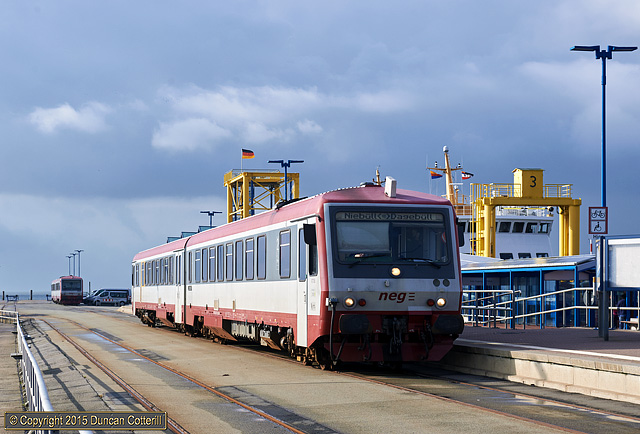
Dagebüll Mole
Both NEG's class 628/629 power-twins were at Dagebüll Mole at 16:30 on 22 September 2015. Nearest the camera, 628.071 and 629.071 waited to leave at 16:35 with train 24 to Niebüll. In the background 628.506 and 629.505 were stabled awaiting their next duty.NEG trains connect at Dagebüll with ferries serving the islands of Amrum and Föhr, one of which is just visible to the right of the nearest DMU. The ferry that is, not the island.
Dagebüll IC
DB's InterCity trains are worked by a variety of traction but this must be amongst the most unusual. NEG's 627.103 worked train 19, the 13:35 from Niebüll to Dagebüll Mole, south from Deezbüll on 29 September 2015. The unit was hauling the Dagebüll portion of IC2072 from Dresden, together with the obligatory generator van.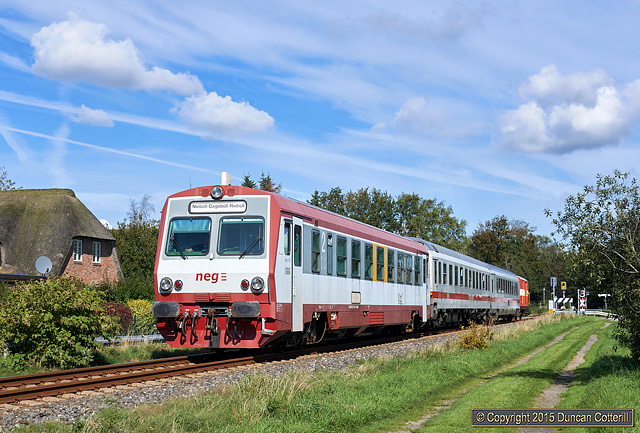
PHOTOGRAPHY
Ten days might seem a long time to photograph a relatively short section of line but it was just about right, especially when you knock off five days for travelling or poor light. The line west of Niebüll runs generally just north of due west, meaning the light is right everywhere at the same time and wrong almost everywhere most of the time. It was a struggle to find good spots for early morning and late afternoon but between around 11:00 and 15:00, you wanted to be in around half a dozen places at the same time.Westerland station itself wasn’t particularly photogenic but the level crossing around 1km to the east provides an acceptable shot of trains in both directions. If walking from the station it’s best to stay on the south side of the line. It’s slightly further but the crossing gates can be closed for 15 or 20 minutes at a time and it avoids the frustration of being stuck on the wrong side when the train you wanted to photograph goes past. There’s an overbridge a further km or so to the east that provides an excellent vantage point from which to photograph departing trains passing the carriage sidings but it’s no good for arrivals.
There’s a shot for eastbounds passing a semaphore at the level crossing around 1km west of Keitum but it’s a bit tight for a double header. Otherwise Keitum was a bit difficult. The open ground at the east end of Morsum station is good for westbound trains and tolerable for eastbounds, provided you crouch down to hide the lampposts behind the train. The best shots in the area are around 3km further east where the Hindenburgdamm makes landfall on the island. This is one of the few places between Niebüll and Westerland where the light is right mid-morning.
I didn’t visit the spot where the Hindenburgdamm reaches the mainland this time but did find a few spots further inland. The damm doesn’t stop at the coast but continues inland for about 3km, past the main and secondary coastal defence dykes, before the line drops down to ground level around 1km west of Klanxbüll. There is a spot on the south side of the line where it crosses the secondary dyke and another at a closed level crossing around 1km nearer to Klanxbüll and both are excellent for westbounds in the late afternoon. There’s also the main road crossing around 1km west of Klanxbüll where a side road leads to a nice shot of an early morning eastbound passing a semaphore. Klanxbüll station itself offers a number of shots of trains passing semaphores. And there are morning shots along the main road to the east in the early morning, provided you like wind turbines.
The west end of Lehnshallig loop is also good for shots of trains passing semaphores but was missed this time as it’s a very long walk from anywhere and I’d been there by car on previous trips. Further to the east there are good morning and evening shots within walking distance of Niebüll and SyltShuttles can be photographed arriving and departing from the platform at Niebüll station.
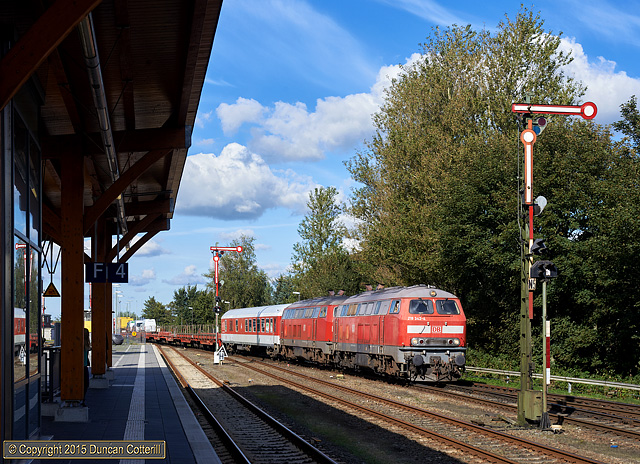
Goldilocks Shot
218.382 and 218.380 passed platform 4 at Niebüll, on their way to the SyltShuttle terminal with train AS-K1437, the 14:10 from Westerland, on 29 September 2015.There was a very narrow window when the light was good for this particular shot. Much earlier and the sides of the loco wouldn't be well lit, much later and the shadow of the platform canopy would be across the track. At 14:45, when AS-K1437 arrived, it was just right.
Hindenburgdamm
218.376 and 218.389 rolled off the west end of the Hindenburgdamm with a Westerland bound shuttle under a fabulous Nordfriesland sky on 26 September 2015. The train was AS-K1432, the 13:16 SyltShuttle from Niebüll.This position is around 30 minutes walk from Morsum station and well worth the hike. Like so many locations between Niebüll and Westerland, the light is right in the middle of the day.
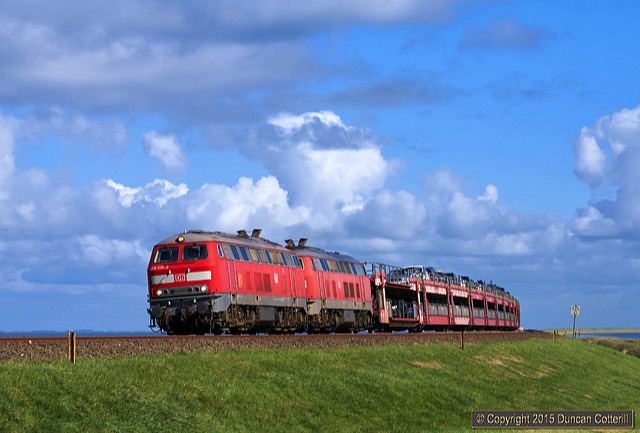
COMMENTS & CONCLUSIONS
With frequent trains and relatively closely spaced stations between Niebüll and Westerland, not to mention the expense and inconvenience of taking a car over to Sylt, it seemed sensible to use the trains to get around. I hadn't appreciated just how much footslogging would be involved though and ended up walking somewhere over 20km on most days, between stations and photspots, often at a very brisk pace to avoid missing a photo or a train to my next location. It proved to be a very practical way to get around although it was hard work. At least the terrain was fairly flat. Most of the locations I ended up at were spotted from the train as the trip progressed.Luckily the poor weather was at the start of the trip and provided the opportunity to explore and check out potential photo locations ready for when the light improved later in the trip. There were a couple of short sunny breaks on the first Tuesday, followed by unremitting gloom on the Wednesday and Thursday. On the Friday I chose to go to Hamburg for the day (subject of a separate report). Saturday and Sunday and Monday were increasingly brighter and then Tuesday and Wednesday were largely sunny. With so many trains and long sunny periods on the last five days, I came away well satisfied.
After getting used to photographing diesels on lines with sparse services, the Westerland - Niebüll line seemed unbelievably busy, particularly at the weekend, when the volume of traffic was almost overwhelming. It wasn't just the frequency of trains that was impressive, it was that every single one of them was loco worked and well over half were hauled by double-headed classic diesels. The Marschbahn doesn't have the hills and forests of northern Bavaria, the mountains of the Allgäu or the spectacular landscape of the Rhein Gorge but it's still quite photogenic in it's way, with semaphore signals and incredible skies. I'd have no hesitation in recommending a visit but you need to be quick. A second class 245 was reported on NOB services as I was typing this up.
Each region of Germany seems to have its own ticketing regime and Schleswig-Holstein is no exception. I was aware of the Schleswig-Holstein Ticket, normal singles and Tageskarte (a return between two places that you can use as often as you like during the day) but there are other options as well. For just over €31 you can get a Tageskarte for the whole Schleswig-Holstein regional network, that's a bit more than a Schleswig-Holstein Ticket but it doesn't have any restrictions on use before 09:00 on weekdays. There are also Wochenkarte, like Tageskarte but valid for a whole week. These are generally between 3 and 4 times the price of a Tageskarte and are available between pairs of stations or for the whole network, the latter costs €108 for a whole week, far less than buying a week's worth of SH Tickets. First Class is also available for all the Tageskarte and Wochenkarte options at the usual 50% extra, well worth considering as many peak services are wedged in second. That included just about every weekend train to or from Westerland and many of the weekday ones as well. No problem getting a seat in First though.
I stayed at the Gastätte Zur Alten Schmiede in the centre of Niebüll, booked through www.booking.com and less than 10 minutes walk from the station. At €50 per night for a tiny drab room and no internet access, it wasn’t cheap but accommodation in this area tends to be expensive. The Wattwurm restaurant, a short walk along the Hauptstrasse, had all the atmosphere that the hotel restaurant lacked, excellent food and free internet access.
Finally, thanks to the diagram compilers, to Phil W and all those who've supplied information. It really does make planning trips like this a lot easier. In turn, hopefully somebody will find something useful in this report.
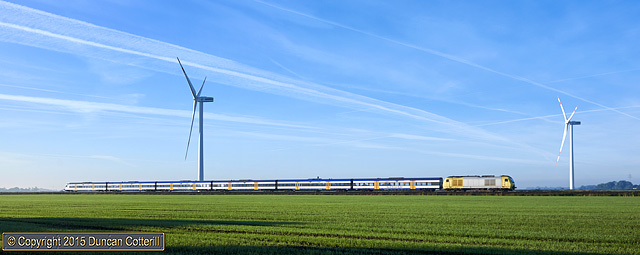
Wind Turbines
An unidentified class 223 propelled NOB81711, the 08:22 from Westerland to Hamburg-Altona, east from Klanxbüll on 29 September 2015.Wind turbines are a common feature on the plains of Nordfriesland and almost impossible to avoid.
Westerland Approach
NOB's 223.054 (aka DE2000-02) approached Westerland with NOB81714, the 12:40 from Hamburg-Altona, on Sunday 27 September 2015.The unsettled weather early in the trip was more than compensated by the clear air and spectacular skies that followed.
